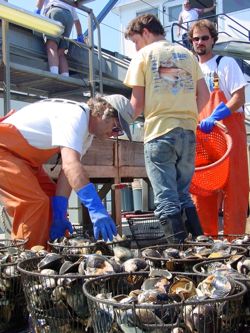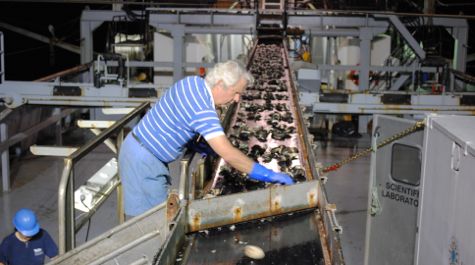New public-private research center will help foster sustainable fisheries
Industry partners help plan—and fund—basic fisheries research
A new 5-year grant from the National Science Foundation to the Virginia Institute of Marine Science will jumpstart a partnership in which commercial anglers and other groups jointly plan—and fund—the research needed to promote sustainable fisheries throughout the Mid-Atlantic and Gulf coast region.
The public-private partnership, formally known as the Science Center for Marine Fisheries, or SCeMFiS, is a cooperative venture managed by VIMS and the University of Southern Mississippi. The Center is led by Dr. Eric Powell of USM’s Gulf Coast Research Laboratory, with Professor Roger Mann directing the SCeMFiS site at VIMS.
The Center’s industry partners—which the National Science Foundation defines as any private or publicly traded company, trade organization, or non-profit group—currently include the Garden State Seafood Association, the National Fisheries Institute Clam Committee, the Northeast Fisheries Science Center, Atlantic Capes Fisheries, Inc., LaMonica Fine Foods, Lunds Fisheries Inc., the National Fisheries Institute Scientific Monitoring Committee, Surfside Seafood Products, and L.D. Amory and Company of Hampton.
Full partners in SCeMFiS contribute $50,000 per year for two voting seats on the Center’s Industry Advisory Board, while a $25,000 annual subscription confers status as an associate partner with a single voting seat.
When asked why L.D. Amory and Co. committed to be a SCeMFiS associate partner, owner C. Meade Amory, said “The key to fisheries management is the best possible science. By industry working together with scientists we have a better chance of getting a better handle on management.”
“Management of these fisheries is difficult to say the least,” Amory adds. “This is a great opportunity to work with scientists to improve stock assessments and modeling, and to make sure that we’re doing everything we can to keep our fisheries sustainable into the future.”
Powell says SCeMFiS is “unique in being the only federal-industry partnership that permits the fishing industry to retain a leadership role in designing the science program. This assures that sustainable fisheries will remain a focus of project design and that the science products will directly address the issues faced by the fishing industry.”
Mann adds that Center activities will “benefit both the commercial and recreational fishing industries while helping to sustain the nation's fish resources.” Research at the center, he says, “will use peer-reviewed science to help improve sampling methods for fisheries surveys, enhance population-dynamics models, develop new approaches to reducing discard, reveal geographic and biological variations in stock structure and dynamics, among many other benefits.”
 Mann says that initial areas of collaborative research will likely involve the surf clam and ocean quahog fisheries; trawl fisheries for squid, mackerel, summer flounder, black sea bass, and other species; and the purse seine fishery for menhaden.
Mann says that initial areas of collaborative research will likely involve the surf clam and ocean quahog fisheries; trawl fisheries for squid, mackerel, summer flounder, black sea bass, and other species; and the purse seine fishery for menhaden.
SCeMFiS is funded through the National Science Foundation’s Industry/University Cooperative Research Center program. These centers are designed to provide the business community with the opportunity to gain access to science to help fulfill their needs. NSF says the highly competitive program—in operation for more than 40 years—has become a model for collaborative research between industry and universities nationwide, with centers in fields as diverse as health care, energy and environment, cloud computing, and homeland security.
Fisheries scientists at VIMS are already involved in a number of science-industry partnerships at the federal level, including the Northeast Area Monitoring and Assessment Program (NEAMAP), the Southeast Area Monitoring and Assessment Program (SEAMAP), and the Sea Scallop Research Set-Aside Program. However, says Mann, SCeMFIS and other Cooperative Research centers allow industry a greater role—and greater fiscal responsibility—in fisheries research.
“SCeMFIS functions like these other programs in that the work is directly applied to industry need,” says Mann, “but unlike those programs, the Center is run by an Industry Advisory Board. The Center and site directors respond to the IAB, and the IAB subscriptions pay for the research. The focus of the research is decided through a format dictated by NSF but voted on by the industry members—it’s their money that we’re spending on the research. So these are very direct industry collaborations.”
The National Science Foundation’s initial support of SCeMFIS comes in the form of a continuing grant in which NSF agrees to provide an initial 5-year seed grant of $529,340, with a statement of intent to provide additional future support if funds are available and results warrant. NSF officials say that investment in SCeMFIS and other cooperative research centers is intended as seed money, with the centers expected to gradually become fully supported by university, industry, state, and/or other non-NSF sponsors. To date, more than 80% of the centers established under the program continue on as successful centers without NSF funding.


